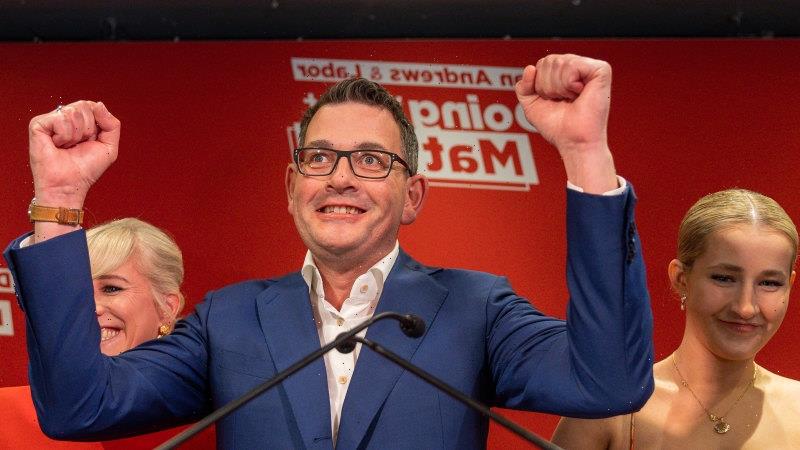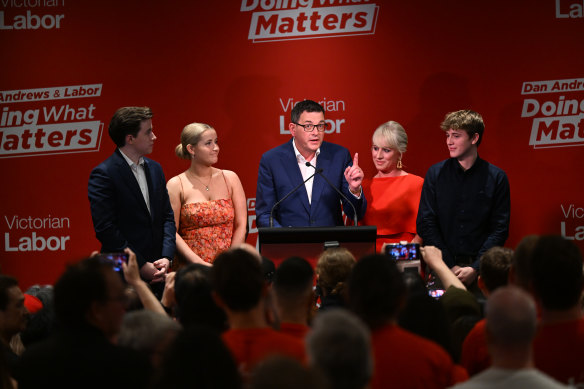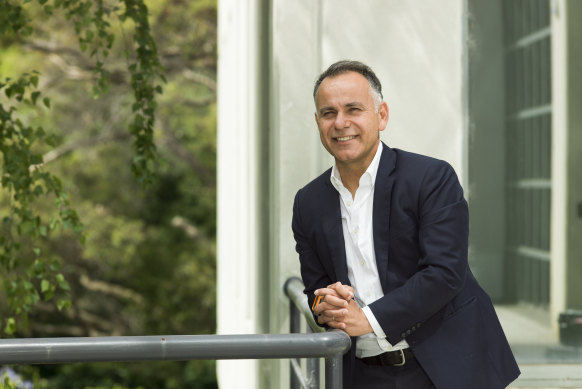Labor poured double the amount of money into social media advertising during the state election campaign as the Liberal Party, prompting calls for the Coalition to be “stronger on social media” at the next election.
New data measuring the amount of money spent by political parties across Meta’s social media platforms Facebook and Instagram estimates Labor’s total ad spend was more than $2 million during the state election campaign, compared to a little over $1 million spent by the Liberals.
Daniel Andrews and his family celebrate his election victory.Credit:Joe Armao
The data, prepared by Populares — a communications firm that has worked on teal independent campaigns — also identifies the electorates most heavily bombarded with digital advertising during the campaign, highlighting the areas where the major parties wanted to gain and retain seats.
In Hawthorn, social media users were inundated with more advertisements than any other electorate with Labor, the Liberals and so-called teal independent candidates spending a combined total of more than $78,000 on advertisements, with Liberal MP John Pesutto and independent candidate Melissa Lowe each forking out more than $30,000 on digital ads for their campaigns.
The neighbouring seat of Kew attracted the second-highest digital advertising budget with candidates spending a collective total of $73,000 on Facebook and Instagram.
According to the Populares AdTracker, the Greens spent less than $500,000 on social media advertisements — half of which was spent in just five seats: Brunswick, Melbourne, Northcote, Prahran and Richmond.
Labor bought more than $20,000 worth of digital advertisements in eight seats — Albert Park ($23,745), Ripon ($20,079), Morwell ($32,752), Cranbourne ($25,721), Bayswater ($36,001), Essendon ($26,234), Ringwood ($20,135) and South Barwon ($20,099). It managed to win or hold all eight electorates except Morwell which was won by the National Party.
The Victorian opposition’s new leader John PesuttoCredit:Elke Meitzel
Ed Coper, co-founder of Populares, said Labor was able to use social media advertising to “circumvent the narrative” in some parts of the media and from the opposition about Daniel Andrews’ perceived unpopularity as well as the anti-lockdown element in the community.
While Labor outspent the Liberals 2:1 in its total advertising on Facebook and Instagram, the opposition spent a combined total of about $100,000 on social media ads in the five key seats in Melbourne’s east (Ashwood, Box Hill, Glen Waverley, Ringwood, Bayswater), which was more than Labor, but it was unable to win any of the seats.
Of the 11 seats where the Liberals spent more than $20,000 on social media ads, the party only managed to pick up one extra seat, Hawthorn.
Pesutto, who represents Hawthorn and was recently elected as opposition leader, told The Age, that while the Liberal Party’s digital profile had improved, it trailed Labor’s.
"We want to be even stronger on social media and I think if you look seat by seat, we trail and we should be doing better," he said.
Digital campaigning has become a vital tool for political parties with the Liberal Party’s own review of its 2018 election loss receiving several submissions, which the review said highlighted “deficiencies in the Party’s advertising social media and other outreach activities to voters”.
Coper said that during the 2022 election the Liberal Party had failed to create “bespoke content” that would engage social media users and often resorted to simply running television commercials online.
”The Andrews government has always been the high watermark in terms of digital advertising in Australia and the Victorian Liberals are competing against a party that understands it the best,” he said.
Four teal independent candidates backed by Simon Holmes a Court’s Climate 200 group spent an estimated $128,000 bombarding social media users in Mornington, Kew, Hawthorn and Caulfield, which were all won by the Liberal Party.
Coper told The Age while the independents tried to emulate the success of teal candidates at May's federal election, they were hindered by donation laws, a shorter lead-up time and a different political landscape.
He said their heavily digital advertising spend “wasn’t for no gain”, pointing to three independents who secured more than 20 per cent of the primary vote which he said was “largely due to their digital spend”.
The National Party had one of the lowest digital advertising budgets, ploughing about $80,000 into social media ads. But the junior Coalition partner spent about half its budget on just three seats — Shepparton, Mildura and Morwell — which it won.
The Morning Edition newsletter is our guide to the day’s most important and interesting stories, analysis and insights. Sign up here.
Most Viewed in National
From our partners
Source: Read Full Article


